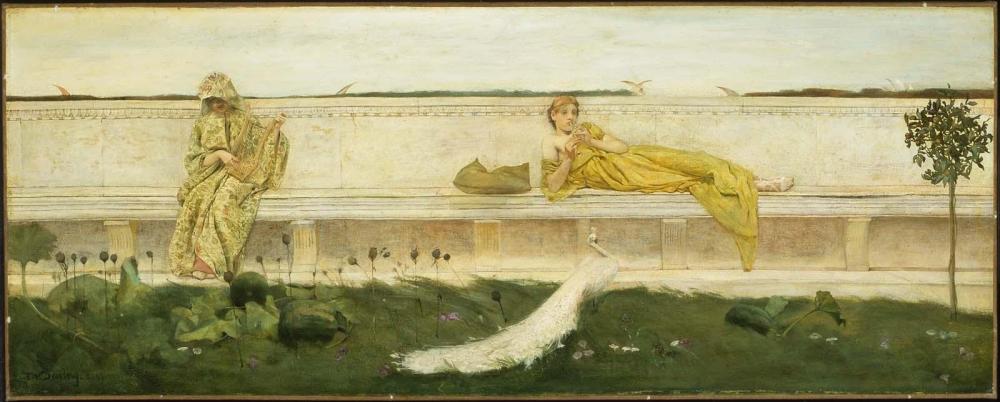Advanced Search 

A Garden
Thomas Wilmer Dewing (American, 1851–1938)
1883
Medium/Technique
Oil on canvas
Dimensions
40.32 x 101.6 cm (15 7/8 x 40 in.)
Credit Line
Bequest of George H. Webster
Accession Number34.131
CollectionsAmericas
ClassificationsPaintings
A native of Boston, Thomas Wilmer Dewing began his career as a lithographer. He first listed himself as a taxidermist and then a clerk in city directories, but by the early 1870s he had started to think of himself as a painter. He traveled to Paris for two years of study, like many American artists in the decades after the Civil War, and returned to Boston to teach at the newly founded School of the Museum of Fine Arts. In 1880 he moved to New York, where he taught at the Art Students League, later explaining that living anywhere other than Manhattan was “camping out.”[1]He and his wife Maria, also a painter, did leave the city to spend each summer in Cornish, New Hampshire, where they became integral members of the art colony that established itself there.
Dewing was interested in contemporary European art and, especially during the early part of his career, he drew inspiration from a variety of sources: Italian, French, and English. A Garden was one of the first paintings he made in the manner of the Aesthetic movement, a style based on British models that emphasized beauty and harmonious design. English painters like Lawrence Alma-Tadema [41.117], whom Dewing especially admired, crafted flawlessly beautiful genre scenes with themes from classical antiquity. In A Garden, Dewing worked in a delicate, realistic style, employing a number of motifs common to those consciously artistic paintings: lovely women in classical robes, a marble bench imagined from Greek and Roman sources, swaying poppies, and elegant peacocks. However Dewing’s garden is hidden, detached from the world beyond the wall where bright sails can be glimpsed plying an unknown sea. The lyre-playing figure is hooded and sits before a patch of ripe melons, symbols of fertility, and poppies, emblems of sleep, dreams, and decadence. The flute player reclines gracefully near a white peacock, a token of marriage, immortality, and also vanity. Yet this combination of objects illustrates no obvious myth or legend, intriguing viewers with its mystery and exquisite grace. Instead of telling a story, each carefully chosen color, pattern, and shape in A Garden is arranged to create a poem in paint.
Notes
1. Susan Hobbs, “Thomas Wilmer Dewing: The Early Years, 1851–1885,” American Art Journal 13, no. 2 (Spring 1981): 24.
This text was adapted from Elliot Bostwick Davis et al., American Painting [http://www.mfashop.com/9020398034.html], MFA Highlights (Boston: MFA Publications, 2003).
Dewing was interested in contemporary European art and, especially during the early part of his career, he drew inspiration from a variety of sources: Italian, French, and English. A Garden was one of the first paintings he made in the manner of the Aesthetic movement, a style based on British models that emphasized beauty and harmonious design. English painters like Lawrence Alma-Tadema [41.117], whom Dewing especially admired, crafted flawlessly beautiful genre scenes with themes from classical antiquity. In A Garden, Dewing worked in a delicate, realistic style, employing a number of motifs common to those consciously artistic paintings: lovely women in classical robes, a marble bench imagined from Greek and Roman sources, swaying poppies, and elegant peacocks. However Dewing’s garden is hidden, detached from the world beyond the wall where bright sails can be glimpsed plying an unknown sea. The lyre-playing figure is hooded and sits before a patch of ripe melons, symbols of fertility, and poppies, emblems of sleep, dreams, and decadence. The flute player reclines gracefully near a white peacock, a token of marriage, immortality, and also vanity. Yet this combination of objects illustrates no obvious myth or legend, intriguing viewers with its mystery and exquisite grace. Instead of telling a story, each carefully chosen color, pattern, and shape in A Garden is arranged to create a poem in paint.
Notes
1. Susan Hobbs, “Thomas Wilmer Dewing: The Early Years, 1851–1885,” American Art Journal 13, no. 2 (Spring 1981): 24.
This text was adapted from Elliot Bostwick Davis et al., American Painting [http://www.mfashop.com/9020398034.html], MFA Highlights (Boston: MFA Publications, 2003).
InscriptionsLower left: T.W. Dewing. 1883; Reverse: A Garden. Thomas W. Dewing. N.Y.
Provenance1883, sold by the artist to Thomas B. Clarke (1848-1931), New York; 1899, Thomas B. Clarke collection sale to Charles Lang Freer (1856-1919), Detroit; by 1901, gift from Freer to Stanford White (1853-1906), New York. After 1906, purchased by John Gellatly (1853-1931), New York. Before 1933, George H. Webster, Haverhill, Mass.; 1934, bequest of George H. Webster to the MFA. (Accession Date: April 5, 1934)
